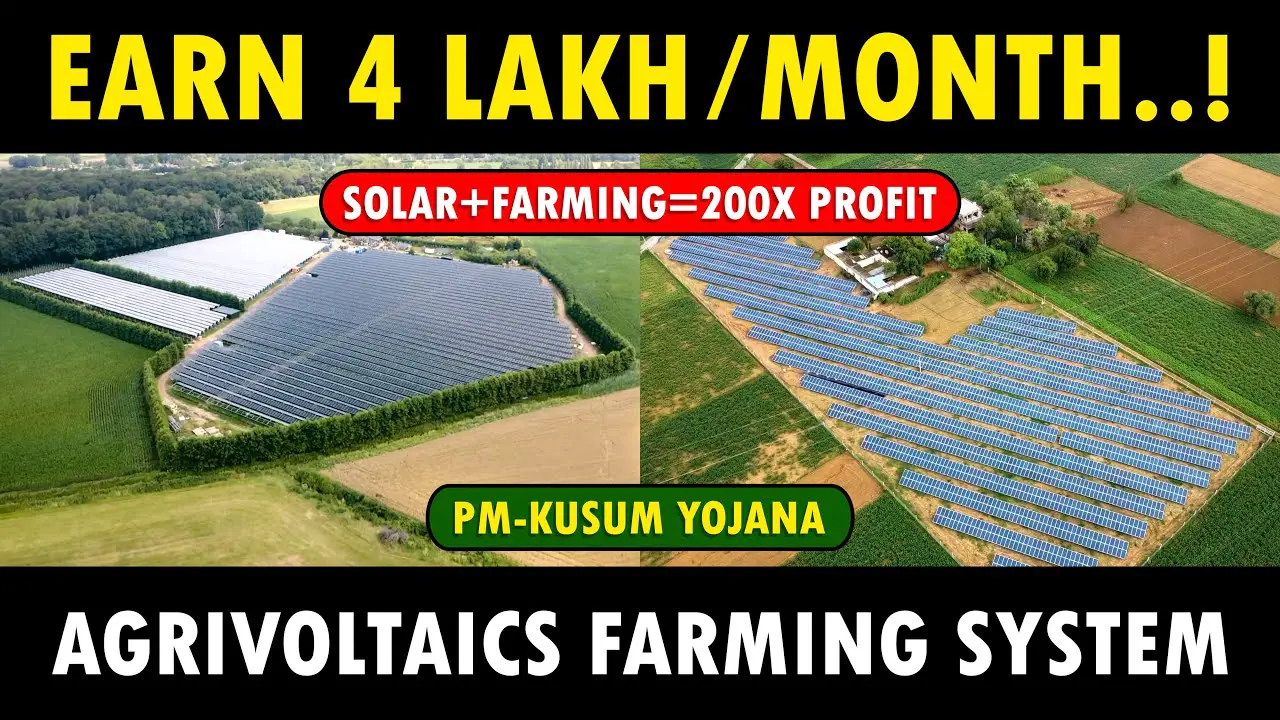New Integrated Agriculture Business Idea (Agrivoltaics)
Ministry of New and Renewable Energy has launched the Pradhan Mantri Kisan Urja Suraksha evam Utthaan Mahabhiyan, PM KUSUM Scheme for farmers for installation of solar pumps and grid-connected solar and other renewable power plants in the country. Under this scheme, Farmers can earn 2 lakh per month in just 2 acres of land.
Agrivoltaics is the simultaneous use of areas of land for both solar photovoltaic power generation and agriculture. The coexistence of solar panels and crops implies a sharing of light between these two types of production, so the design of agrivoltaic facilities requires trading off such objectives as optimizing crop yield, crop quality, and energy production.
In this video, we will give complete information on Agrivoltaics and PM KUSUM Scheme.
Agriculture uses an enormous amount of resources. It takes A LOT of water and energy to grow all of our food! 85% of global water consumption is used for irrigation, and over one-third of all greenhouse gases are attributed to agriculture.
At the same time, our demand for food is only growing. The global population, now at 7.5 billion, is estimated to reach 9.8 billion people by 2050. We will need to nearly double our current food production to meet that demand.
We will also need to improve access to food, reduce food waste, and address inequities related to food deserts. Food is complicated and approaches to a dynamic and sustainable food system are multifaceted. But for the next three minutes, let’s focus on the future production and resource management side of the equation.
Looking at the water issue alone, with current agricultural methods, there will be nowhere near enough water to grow even the current level of food production by 2050. And we are all aware of the high cost of fossil fuels on both our wallets and the environment.
If the status quo remains, we will likely be looking at food shortages which in turn could cause social unrest and potential economic collapse.
Agriculture has always adapted to meet the dynamic needs of a changing society. Innovations in technology have driven incredible progress over time – from tractors and pest management to breeding and genomics.
Today, most growers are accustomed to exploring new methods of addressing emerging challenges in agriculture and continue to look for ways to mitigate risks brought on by a changing climate.

Agrivoltaics
Water, energy, and agriculture are the bedrock of modern civilization. And while many technologies have advanced these components separately, few have aimed to address all three components at once. It is time to step back and reimagine their relationship.
This new technology promises to improve food production and reduce water use, while also creating energy and additional revenue. Essentially, the solar panels placed on the same land where crops are grown allow growers to harvest the power of the sun twice.
A recent study estimates that converting just 1% of Indian farmland to agrivoltaics could meet our national renewable energy targets and save water and create a sustainable long-term food system. It will also create new revenue opportunities for family farms which are currently facing increasing economic challenges, with a 23% increase in bankruptcy filings over the past year. The solar panels also help plants grow more efficiently by needing less water.
How exactly do solar panels help plants use less water?
See, plants have a limit to how much sun they can use. It’s called the light saturation point. Once reached, any light beyond that point does not increase photosynthesis or help the plant grow, it only increases the plant’s water demand. It simply makes the plant sweat, which in turn makes it more thirsty.
Solar panels can be positioned to allow plants just the right amount of sunlight, and then the excess sunlight can be harvested for electricity – and produce more than they would without crops below them.
That’s right. Plants help keep the solar panels cool, which makes them more productive. Our studies have shown that panels positioned above plants produce up to 10% more electricity.
Agrivoltaics is a symbiotic relationship where both the solar panels and the crops benefit because they help each other perform better.
The electricity can be used to run the farm with electric tractors and equipment and to power precision Agri technology that helps further reduce water usage. Surplus energy can be stored in battery banks or sent to the grid for consumer use. It’s a win-win-win relationship between the three most foundational elements of modern life: food, water, and energy.

PM Kusum Scheme
PM-KUSUM Scheme is aimed at ensuring energy security for farmers in India, along with honoring India’s commitment to increase the share of installed capacity of electric power from non-fossil-fuel sources to 40% by 2030.
The PM-KUSUM Scheme was launched in 2019 with 3 components. That is component A, Component B, and Component C. Here we are going to talk only about Component A.
Landowners can set up 500kW to 2MW capacity ground-mounted solar PV plants with Own investment or Lease basis.
The minimum land requirement is 2 acres for 500kW and 4 acres for 1MW. The state electricity department will buy generated electricity from farmers. There will be 25 years agreement between Farmers and the government.
If you’re doing it by your own investment, Around Rs 3 Crore is required to install a 1MW solar plant. which will generate approximately 12 lakh units per year. So farmers can earn up to 4 lakh per month.
If you’re giving your land for lease, then the government will pay rent. Now Kerala Electricity board is paying more than 50000₹ per year for every 1-acre land.
Interested farmers may register online specifying the preferable mode of participation.
Benefits of Agrivoltaics and PM Kusum scheme
It will help meet future demand by growing more food, and using less water, while also creating sustainable energy at the same time.
This type of systems-thinking approach is the only way to solve the intertwined issues of long-term sustainable farming, energy production, and water conservation. PM Kusum Scheme may be going to increase farmers’ income.
Also View: Reference

